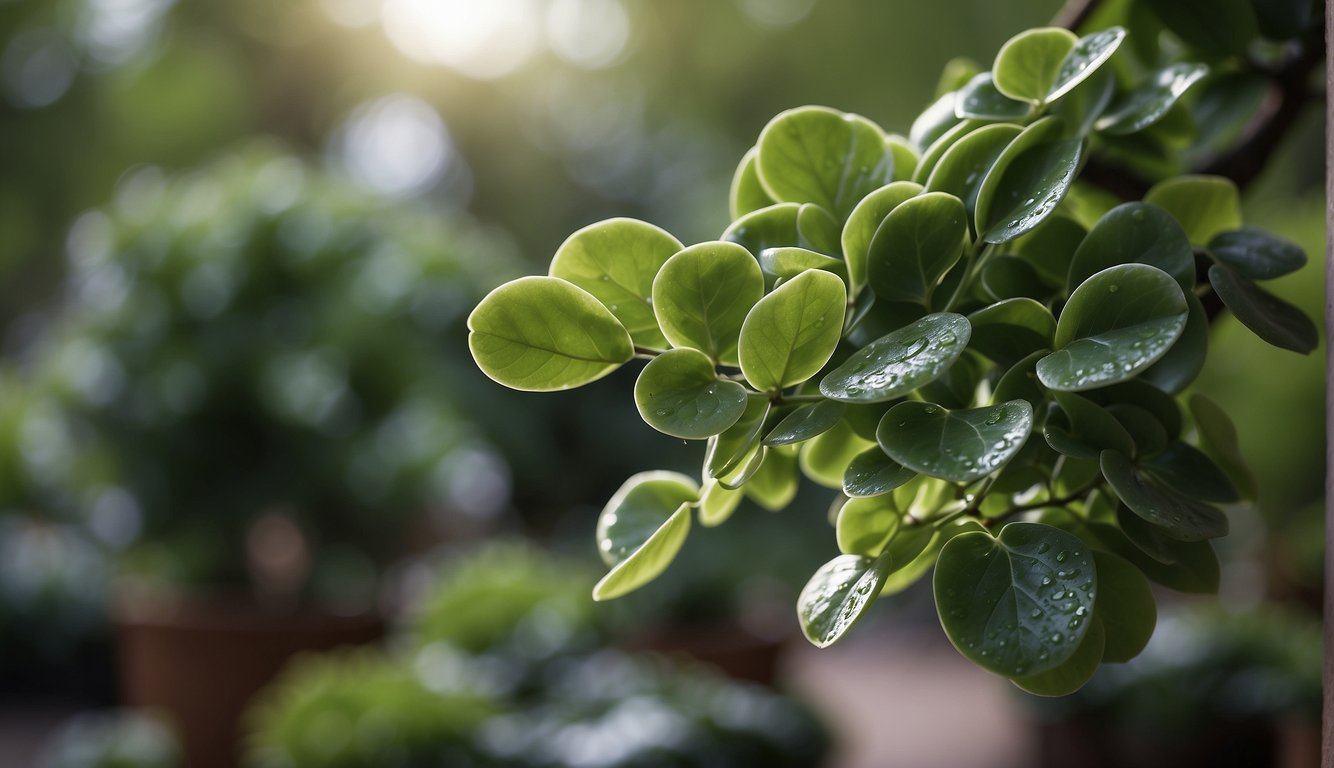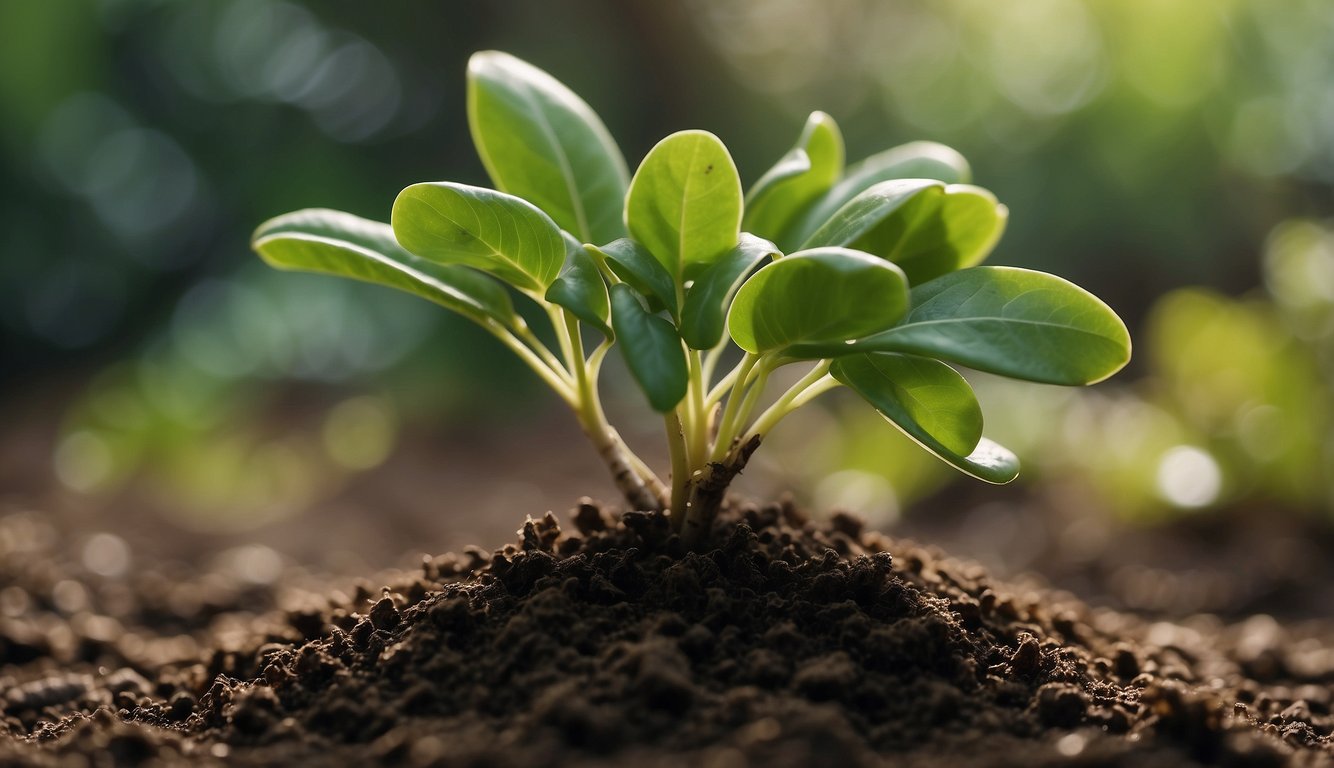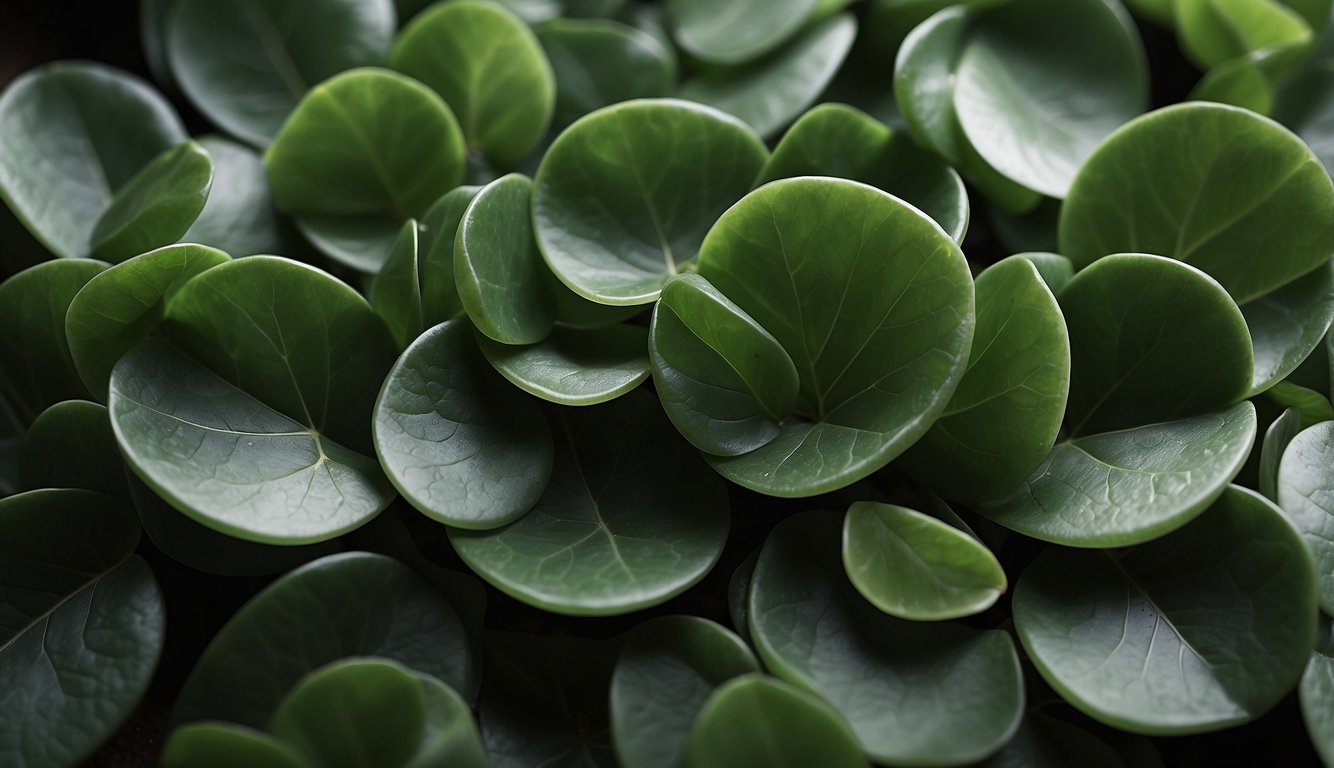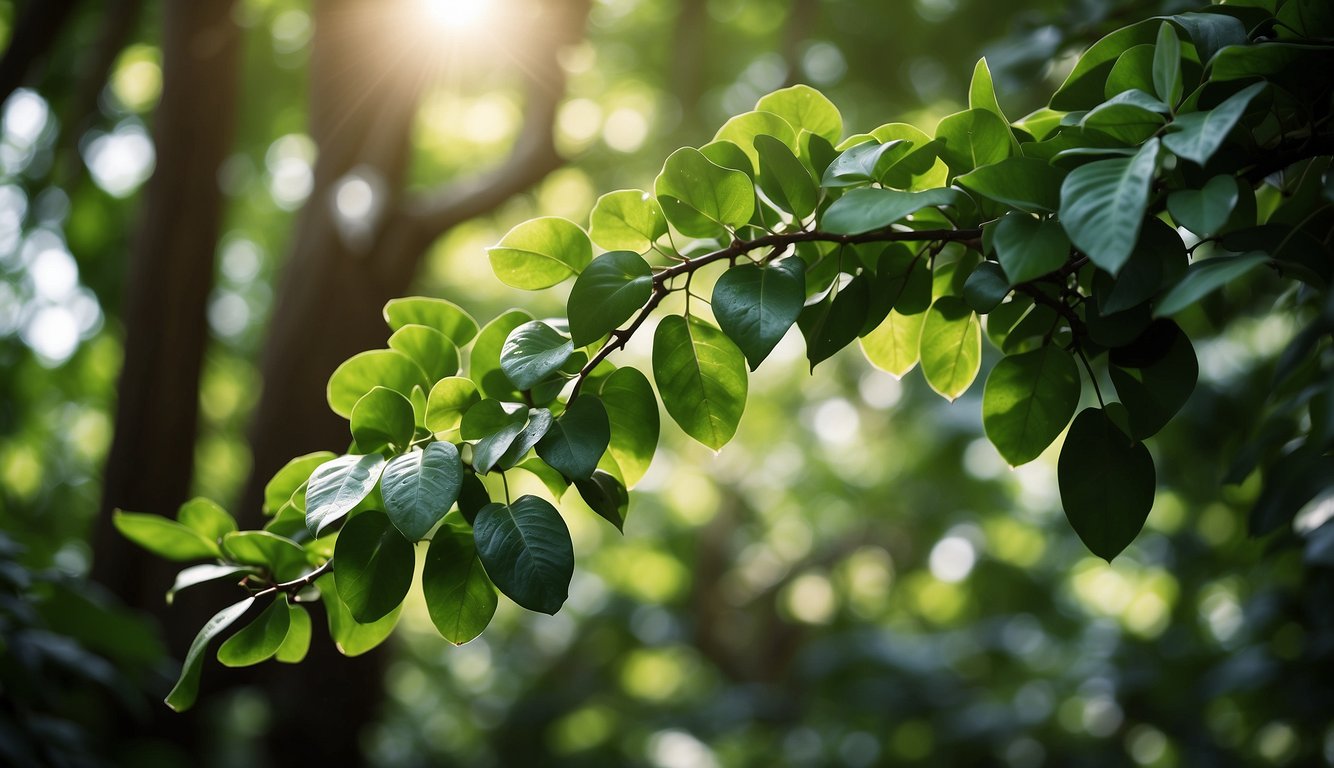TheHerbProf.com is a treasure trove of knowledge for those interested in natural healing and herbal remedies. The website is run by Paul Johnston MD. A naturopathic who has not only received extensive education in the field but also has personal experience in self-healing.
Jade leaves are a popular houseplant choice for many people due to their easy care and attractive appearance. The plant features thick, woody stems topped by green, fleshy leaves with an oval shape. Jade plants are succulents, which makes them fairly resilient and capable of living a long, long time with proper care.
One of the most distinctive features of jade plants is their leaves. The leaves of a jade plant are thick and fleshy, with a glossy sheen. They are typically a deep green color, although some varieties may have a slightly bluish or grayish tint. Jade leaves are oval-shaped and can range in size from small and delicate to large and robust, depending on the age and health of the plant.
If you’re considering adding a jade plant to your collection of houseplants, it’s important to understand how to care for them properly. With the right care, your jade plant can thrive for many years, providing you with a beautiful and low-maintenance addition to your home. In the following sections, I will provide you with some tips and tricks for caring for your jade plant, including information on soil, water, light, and more.
Jade Plant Overview
Jade plant, also known as Crassula ovata, is a succulent plant that belongs to the Crassulaceae family. It is a popular indoor plant that is grown for its attractive appearance and low maintenance. The plant is native to South Africa, but it is now widely cultivated in many countries around the world.
Botanical Profile
Jade plant is a small, slow-growing shrub that can grow up to 3 feet tall. It has thick, fleshy leaves that are oval-shaped and pointed at the tip. The leaves are usually green, but they can also be variegated with white or yellow. The plant produces small, star-shaped white or pink flowers in the winter.
The plant belongs to the Crassula genus, which includes more than 350 species of succulent plants. The genus name “Crassula” comes from the Latin word “crassus,” which means thick or fat. This refers to the thick, fleshy leaves that are characteristic of the plants in this genus.
Cultural Significance
Jade plant is also known as the “money plant” or “good luck plant” in many cultures. It is believed to bring good luck and prosperity to the home. In Feng Shui, the plant is placed in the southeast corner of the home to attract wealth and success.
Jade plant is also a popular gift for housewarming, weddings, and other special occasions. It is a symbol of friendship, prosperity, and longevity.
Jade plant is a beautiful and easy-to-care-for indoor plant that has cultural significance in many parts of the world. Its botanical profile and cultural significance make it a popular choice for many plant enthusiasts.
Cultivation and Care – Jade Leaves

Optimal Growing Conditions
To grow and care for jade leaves, I need to provide them with optimal growing conditions. Jade plants thrive in bright, indirect light. A south-facing or west-facing window is an excellent location for these plants. Jade plants are succulents and require well-draining soil. I will use a succulent potting mix, which is a blend of sand, perlite, and peat moss.
Planting and Repotting
When planting jade leaves, I will choose a container with drainage holes to ensure proper drainage. I will fill the container with a succulent potting mix and plant the jade leaf. When repotting, I will choose a container that is one size larger than the current container. I will also use fresh soil when repotting. Repotting should be done every two to three years.
Watering Requirements – Jade Leaves
Jade plants require infrequent watering. During the spring and summer, I will water the plant frequently to keep the soil moist but never soggy. In the winter, I will reduce watering to once per month. Overwatering can cause root rot, which is a common problem with jade plants.
Soil and Potting Mix
Jade plants require well-draining soil. A succulent potting mix is the best option for these plants. The mix should be a blend of sand, perlite, and peat moss. I can also mix in coir and crushed pumice to encourage good drainage and keep the jade plant from rotting.
Jade plants are low-maintenance and do not require frequent fertilizing. When fertilizing, I will use a balanced, water-soluble fertilizer. I will fertilize the plant every two months during the growing season.
Jade plants are toxic to humans and pets if ingested. Therefore, I will keep them out of reach of children and pets.
Overall, jade plant care is relatively easy. By providing the plant with optimal growing conditions, well-draining soil, and infrequent watering, I can expect new growth and even blooms.
Propagation Techniques – Jade Leaves

Jade plants are easy to propagate, making them a great choice for beginner gardeners. There are two main techniques for propagating jade plants: stem cuttings and leaf cuttings.
Stem Cuttings
Stem cuttings are the most popular way to propagate jade plants. Cut a stem from the parent plant, making sure it has at least one node. Nodes are the points where leaves attach to the stem. Cut the stem at a 45-degree angle using a clean, sharp knife or scissors. Allow the cutting to callous over for a few days before planting it in well-draining soil. Water the soil lightly and place the pot in a bright, sunny location. Within a few weeks, the cutting should start to grow roots.
Leaf Cuttings
Leaf cuttings are another way to propagate jade plants. Choose a healthy leaf from the parent plant and remove it with a clean, sharp knife or scissors. Allow the leaf to callous over for a few days before planting it in well-draining soil. Water the soil lightly and place the pot in a bright, sunny location. Within a few weeks, small plantlets should start to grow from the base of the leaf.
When propagating variegated jade plants, it’s important to take stem cuttings from the green, non-variegated parts of the plant. Variegated parts of the plant are less likely to root successfully.
To ensure a successful propagation, make sure to use a well-draining soil mix and water the soil lightly. Overwatering can cause the cutting to rot, while underwatering can cause the cutting to dry out.
Propagating jade plants is an easy and rewarding process. By using stem cuttings or leaf cuttings, you can quickly grow new plants and expand your collection. Just remember to be patient and provide the right growing conditions for your cuttings to thrive.
Pests and Diseases – Jade Leaves

As a jade plant owner, I know that pests and diseases can be a real problem. In this section, I will cover the most common pests and diseases that jade plants can suffer from, and how to prevent them.
Common Pests – Jade Leaves
Jade plants can be susceptible to pests such as mealybugs, spider mites, and scale insects. If you notice any of these pests on your plant, it is important to act quickly to prevent them from spreading.
To get rid of mealybugs, you can use rubbing alcohol on a cotton swab to remove them from your plant. For spider mites, you can use a mixture of water and dish soap to spray your plant. Scale insects can be removed by using a cotton swab dipped in rubbing alcohol.
Preventing pests is also important. You can do this by regularly inspecting your plant for any signs of pests and keeping your plant healthy by not overwatering it.
Disease Prevention
Jade plants can also suffer from diseases such as stem rot, which is caused by overwatering. To prevent stem rot, make sure you do not overwater your plant and that the soil has proper drainage.
Another way to prevent diseases is to keep your plant healthy by providing it with the right amount of sunlight and fertilizer. If you notice yellow leaves or other signs of stress, it may be a sign that your plant is not getting enough sunlight or nutrients.
It is also important to note that jade plants are toxic to pets, so make sure to keep them out of reach of any curious animals.
Overall, by taking care of your jade plant and keeping an eye out for any signs of pests and diseases, you can ensure that your plant stays healthy and beautiful for years to come.
Varieties and Hybrids – Jade Leaves

Popular Varieties – Jade Leaves
Jade plants are known for their thick, succulent leaves and are a popular choice for indoor gardening. Some of the most popular varieties of jade plants include Gollum Jade, Variegated Jade, and Sunset Jade. Gollum Jade is easily recognizable by its tubular leaves, which resemble the character Gollum from J.R.R. Tolkien’s “The Lord of the Rings.” Variegated Jade, as the name suggests, has leaves with a mix of green and white colors, giving it a unique appearance. Sunset Jade, on the other hand, has leaves that turn red at the tips when exposed to bright sunlight, adding a touch of color to any indoor garden.
Creating Hybrids
Jade plants are also popular for hybridization, with many gardeners experimenting with different varieties to create new and unique plants. One of the most popular hybrids is the Compact Jade, which is a cross between the Gollum and the Variegated Jade. This plant has compact leaves with a mix of green and white colors, making it a great addition to any indoor garden.
Another popular hybrid is the Variegata Jade, which is a cross between the Variegated Jade and the Gollum Jade. This plant has leaves with a mix of green and white colors, but with a unique twist – the leaves are also tubular like the Gollum Jade. This hybrid is a great choice for gardeners looking for a unique plant to add to their collection.
Overall, jade plants are a versatile and popular choice for indoor gardening, with a wide variety of colors, shapes, and sizes to choose from. Whether you’re a seasoned gardener or just starting out, there’s sure to be a jade plant variety or hybrid that will suit your needs.
Jade Plants in Landscaping – Jade Leaves

As a landscape designer, I often recommend Jade plants to my clients for their versatility and low maintenance. These plants are native to South Africa and have become popular houseplants all over the world. However, they are also great for outdoor use.
Outdoor Use – Jade Leaves
Jade plants make excellent shrubs for landscaping due to their hardiness and resistance to neglect. They can withstand direct sunlight and thrive in well-draining soil. They are also drought-resistant and can survive in low water conditions. Jade plants are perfect for xeriscaping and can add a touch of greenery to a dry landscape.
Indoor Aesthetics
Jade plants are also great for indoor aesthetics. They can be grown as bonsai trees or as regular houseplants. They have a unique, fleshy appearance that adds texture and depth to any room. Jade leaves are also great air purifiers and can help improve indoor air quality. Jade plants prefer bright, indirect light, but can also tolerate low light conditions.
Overall, Jade plants are a great addition to any landscape or indoor space. They are easy to care for and can add a touch of greenery to any environment. With their versatility and hardiness, they are a must-have for any plant lover.
Jade Leaves
Let’s delve into the world of Jade leaves and their fascinating characteristics.
Firstly, we have the succulent nature of Jade leaves. They store water, making Jade plants drought-tolerant. Handy, right?
Next, let’s talk about light. Jade leaves love sunlight. It helps them maintain their vibrant green color. So, find a sunny spot!
Ever heard of pruning? Pruning helps Jade plants maintain their bushy appearance. And guess what? The pruned leaves can be propagated to grow new plants! You can check our homepage here.
And let’s not forget care. Jade leaves are sensitive to overwatering. So, water sparingly and let the soil dry out between waterings.
Remember, folks, every leaf tells a story. So, let’s keep exploring, keep learning, and keep appreciating the wonders of nature!
For more plant wisdom, don’t forget to visit my homepage at theherbprof.com. Keep those green thumbs up!
References – Jade Leaves
Little Herb Encyclopedia, by Jack Ritchason; N.D., Woodland Publishing Incorporated, 1995
The Ultimate Healing System, Course Manual, Copyright 1985, Don Lepore
Planetary Herbology, Michael Tierra, C.A., N.D., Lotus Press, 1988
Handbook of Medicinal Herbs, by James A. Duke, Pub. CRP Second Edition 2007
The Complete Medicinal Herbal, by Penelope Ody, Published by Dorling Kindersley
Check the Following Articles!
How to Get Orchids to Rebloom: Tips and Tricks
Pale Tomato Leaves: Causes and Solutions
How to Get Rid of Flies in Potted Plants?
Frequently Asked Questions – Jade Leaves

Why are my jade plant leaves turning yellow?
If your jade plant leaves are turning yellow, it may be due to overwatering, underwatering, or poor drainage. Make sure to water your jade plant only when the top inch of soil is dry to the touch. Also, ensure that the pot has proper drainage holes to prevent water from accumulating at the bottom.
What are the benefits of having a jade plant at home?
Jade plants are known for their air-purifying qualities and ability to remove harmful toxins from the air. They are also low-maintenance and can thrive in a variety of lighting conditions, making them a great addition to any home or office.
Can you grow a jade plant both indoors and outdoors?
Jade plants can be grown both indoors and outdoors, but they are sensitive to cold temperatures and should be protected from frost. If you live in a colder climate, it is best to keep your jade plant indoors during the winter months.
Are Crassula and jade plants the same species?
Yes, Crassula ovata, also known as the jade plant, is a species of succulent in the Crassulaceae family.
What are the uses of jade plant leaves?
Jade plant leaves can be used to propagate new plants. Simply cut a healthy leaf from the plant and allow it to dry for a few days before planting it in well-draining soil.
Is it safe to consume jade plant leaves?
No, jade plant leaves are not safe for consumption and can be toxic to pets if ingested. It is best to keep jade plants out of reach of children and pets.


